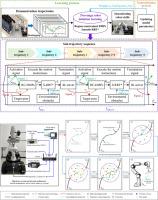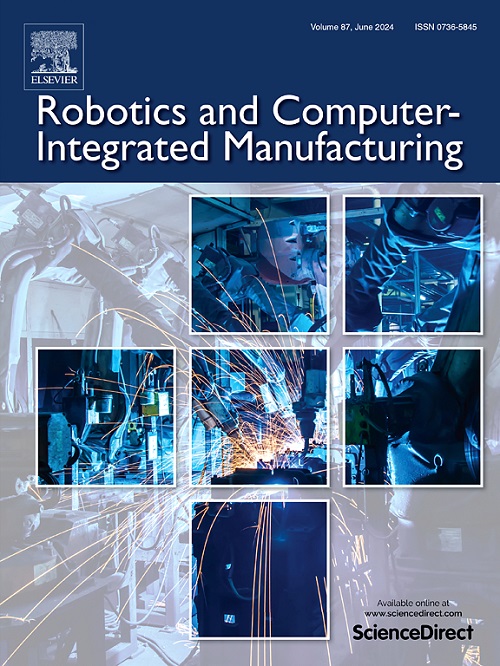TS-RIL:一种具有运动轨迹学习和障碍物回避的两阶段机器人模仿学习框架
IF 11.4
1区 计算机科学
Q1 COMPUTER SCIENCE, INTERDISCIPLINARY APPLICATIONS
引用次数: 0
摘要
机器人模仿学习是基于机器人的智能制造领域的一个重要研究和应用方向。该技术旨在提高机器人在非结构化环境下操作的自主性和鲁棒性。本文提出了一种具有运动轨迹学习和避障功能的两阶段机器人模仿学习框架,命名为TS-RIL。具体而言,本文提出的TS-RIL由基于区域约束动态运动原语的运动轨迹学习算法(rc - dmp)和基于光滑快速探索随机树星的避障算法(S-RRT*)组成,其基本思想是将机器人模仿学习分为运动轨迹学习阶段和避障阶段。在运动轨迹学习阶段,我们设计了一个基于人工势场的耦合项,将dmp扩展到rc - dmp,并通过实时更新强迫项、缩放因子和收敛因子的权重等学习参数生成约束区域的学习轨迹。然后在避障阶段,提出S-RRT*算法,在局部障碍物区域搜索光滑运动轨迹,并将其与rc - dmp生成的轨迹重新组合,概括出新的无碰撞运动轨迹。最后,我们进一步开发了连续rc - dmp系统架构,使机器人的轨迹学习、避障和运动执行可以依次交替进行。为了评估所提出的TS-RIL的整体性能,我们开发了一个基于机器人操作系统(ROS)的算法验证平台,并在复杂的现实场景中进行了一系列典型的原型实验。实验结果表明,我们的TS-RIL能够显著提高机器人运动轨迹学习和泛化的有效性和鲁棒性,在效率、路径长度和成功率方面都优于现有的机器人运动轨迹学习方法。本文章由计算机程序翻译,如有差异,请以英文原文为准。

TS-RIL: A two-stage robot imitation learning framework with motion trajectory learning and obstacle avoidance in real-world operating scenarios
Robot imitation learning is an important research and application direction in the field of robot-based intelligent manufacturing. This technology aims to enhance the autonomous and robustness of robot manipulation in unstructured environments. In this paper, we propose a two-stage robot imitation learning framework with motion trajectory learning and obstacle avoidance, named TS-RIL. Specifically, the proposed TS-RIL consists of a motion trajectory learning algorithm based on the region-constrained dynamic motion primitives (RC-DMPs) and an obstacle avoidance algorithm based on the smooth rapidly-exploring random tree star (S-RRT*), and its basic idea is to divide the robot imitation learning into two stages: motion trajectory learning stage and obstacle avoidance stage. In the motion trajectory learning stage, we design a coupling term based on artificial potential field to extend DMPs to RC-DMPs, and generate the learning trajectories in the constrained regions by real-time updating the learning parameters such as the weights of the forcing term, scaling factor and convergence factor. Then in the obstacle avoidance stage, we propose the S-RRT* algorithm to search for a smooth motion trajectory in the local obstacle region, and recombine it with the trajectory generated by RC-DMPs to generalize a new collision-free motion trajectory. Finally, we further develop the continuous RC-DMPs system architecture, which enables robot trajectory learning, obstacle avoidance and motion execution can be performed sequentially and alternately. To evaluate the overall performance of the proposed TS-RIL, we develop an algorithm verification platform based on the Robot Operating System (ROS) and conduct a series of typical prototype experiments in complex real-world scenarios. The experimental results demonstrate that our TS-RIL can significantly improve the effectiveness and robustness of robot motion trajectory learning and generalization, and outperforms the existing robot motion trajectory learning methods in terms of efficiency, path length and success rate.
求助全文
通过发布文献求助,成功后即可免费获取论文全文。
去求助
来源期刊
CiteScore
24.10
自引率
13.50%
发文量
160
审稿时长
50 days
期刊介绍:
The journal, Robotics and Computer-Integrated Manufacturing, focuses on sharing research applications that contribute to the development of new or enhanced robotics, manufacturing technologies, and innovative manufacturing strategies that are relevant to industry. Papers that combine theory and experimental validation are preferred, while review papers on current robotics and manufacturing issues are also considered. However, papers on traditional machining processes, modeling and simulation, supply chain management, and resource optimization are generally not within the scope of the journal, as there are more appropriate journals for these topics. Similarly, papers that are overly theoretical or mathematical will be directed to other suitable journals. The journal welcomes original papers in areas such as industrial robotics, human-robot collaboration in manufacturing, cloud-based manufacturing, cyber-physical production systems, big data analytics in manufacturing, smart mechatronics, machine learning, adaptive and sustainable manufacturing, and other fields involving unique manufacturing technologies.

 求助内容:
求助内容: 应助结果提醒方式:
应助结果提醒方式:


